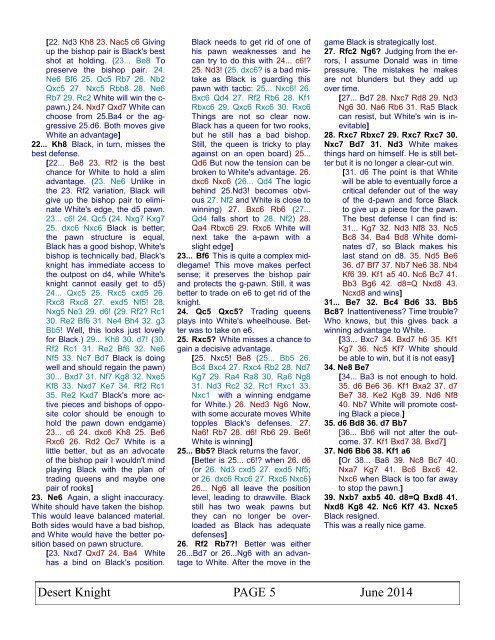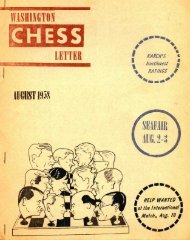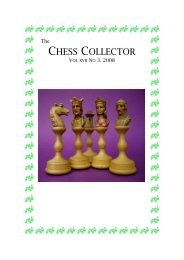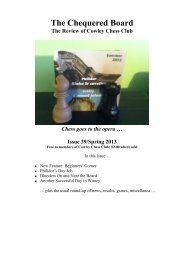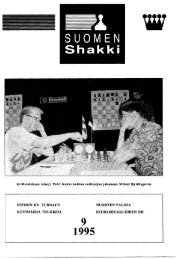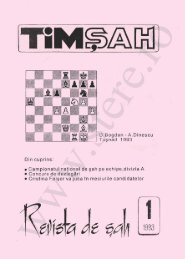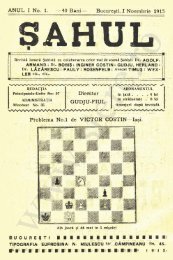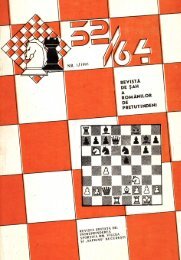Desert Knight
El ajedrez es un juego, considerado un deporte, entre dos personas, cada una de las cuales dispone de 16 piezas móviles que se colocan sobre un tablero dividido en 64 escaques. En su versión de competición está considerado como un deporte.
El ajedrez es un juego, considerado un deporte, entre dos personas, cada una de las cuales dispone de 16 piezas móviles que se colocan sobre un tablero dividido en 64 escaques. En su versión de competición está considerado como un deporte.
Create successful ePaper yourself
Turn your PDF publications into a flip-book with our unique Google optimized e-Paper software.
[22. Nd3 Kh8 23. Nac5 c6 Giving<br />
up the bishop pair is Black's best<br />
shot at holding. (23... Be8 To<br />
preserve the bishop pair. 24.<br />
Ne6 Bf6 25. Qc5 Rb7 26. Nb2<br />
Qxc5 27. Nxc5 Rbb8 28. Ne6<br />
Rb7 29. Rc2 White will win the c-<br />
pawn.) 24. Nxd7 Qxd7 White can<br />
choose from 25.Ba4 or the aggressive<br />
25.d6. Both moves give<br />
White an advantage]<br />
22... Kh8 Black, in turn, misses the<br />
best defense.<br />
[22... Be8 23. Rf2 is the best<br />
chance for White to hold a slim<br />
advantage. (23. Ne6 Unlike in<br />
the 23. Rf2 variation, Black will<br />
give up the bishop pair to eliminate<br />
White's edge, the d5 pawn.<br />
23... c6! 24. Qc5 (24. Nxg7 Kxg7<br />
25. dxc6 Nxc6 Black is better;<br />
the pawn structure is equal,<br />
Black has a good bishop, White's<br />
bishop is technically bad, Black's<br />
knight has immediate access to<br />
the outpost on d4, while White's<br />
knight cannot easily get to d5)<br />
24... Qxc5 25. Rxc5 cxd5 26.<br />
Rxc8 Rxc8 27. exd5 Nf5! 28.<br />
Nxg5 Ne3 29. d6! (29. Rf2? Rc1<br />
30. Re2 Bf6 31. Ne4 Bh4 32. g3<br />
Bb5! Well, this looks just lovely<br />
for Black.) 29... Kh8 30. d7! (30.<br />
Rf2 Rc1 31. Re2 Bf6 32. Ne6<br />
Nf5 33. Nc7 Bd7 Black is doing<br />
well and should regain the pawn)<br />
30... Bxd7 31. Nf7 Kg8 32. Nxe5<br />
Kf8 33. Nxd7 Ke7 34. Rf2 Rc1<br />
35. Re2 Kxd7 Black's more active<br />
pieces and bishops of opposite<br />
color should be enough to<br />
hold the pawn down endgame)<br />
23... c6 24. dxc6 Kh8 25. Be6<br />
Rxc6 26. Rd2 Qc7 White is a<br />
little better, but as an advocate<br />
of the bishop pair I wouldn't mind<br />
playing Black with the plan of<br />
trading queens and maybe one<br />
pair of rooks]<br />
23. Ne6 Again, a slight inaccuracy.<br />
White should have taken the bishop.<br />
This would leave balanced material.<br />
Both sides would have a bad bishop,<br />
and White would have the better position<br />
based on pawn structure.<br />
[23. Nxd7 Qxd7 24. Ba4 White<br />
has a bind on Black's position.<br />
Black needs to get rid of one of<br />
his pawn weaknesses and he<br />
can try to do this with 24... c6!?<br />
25. Nd3! (25. dxc6? is a bad mistake<br />
as Black is guarding this<br />
pawn with tactic: 25... Nxc6! 26.<br />
Bxc6 Qd4 27. Rf2 Rb6 28. Kf1<br />
Rbxc6 29. Qxc6 Rxc6 30. Rxc6<br />
Things are not so clear now.<br />
Black has a queen for two rooks,<br />
but he still has a bad bishop.<br />
Still, the queen is tricky to play<br />
against on an open board) 25...<br />
Qd6 But now the tension can be<br />
broken to White's advantage. 26.<br />
dxc6 Nxc6 (26... Qd4 The logic<br />
behind 25.Nd3! becomes obvious<br />
27. Nf2 and White is close to<br />
winning) 27. Bxc6 Rb6 (27...<br />
Qd4 falls short to 28. Nf2) 28.<br />
Qa4 Rbxc6 29. Rxc6 White will<br />
next take the a-pawn with a<br />
slight edge]<br />
23... Bf6 This is quite a complex middlegame!<br />
This move makes perfect<br />
sense; it preserves the bishop pair<br />
and protects the g-pawn. Still, it was<br />
better to trade on e6 to get rid of the<br />
knight.<br />
24. Qc5 Qxc5? Trading queens<br />
plays into White's wheelhouse. Better<br />
was to take on e6.<br />
25. Rxc5? White misses a chance to<br />
gain a decisive advantage.<br />
[25. Nxc5! Be8 (25... Bb5 26.<br />
Bc4 Bxc4 27. Rxc4 Rb2 28. Nd7<br />
Kg7 29. Ra4 Ra8 30. Ra6 Ng8<br />
31. Nd3 Rc2 32. Rc1 Rxc1 33.<br />
Nxc1 with a winning endgame<br />
for White.) 26. Ned3 Ng6 Now,<br />
with some accurate moves White<br />
topples Black's defenses. 27.<br />
Na6! Rb7 28. d6! Rb6 29. Be6!<br />
White is winning]<br />
25... Bb5? Black returns the favor.<br />
[Better is 25... c6!? when 26. d6<br />
(or 26. Nd3 cxd5 27. exd5 Nf5;<br />
or 26. dxc6 Rxc6 27. Rxc6 Nxc6)<br />
26... Ng6 all leave the position<br />
level, leading to drawville. Black<br />
still has two weak pawns but<br />
they can no longer be overloaded<br />
as Black has adequate<br />
defenses]<br />
26. Rf2 Rb7?! Better was either<br />
26...Bd7 or 26...Ng6 with an advantage<br />
to White. After the move in the<br />
game Black is strategically lost.<br />
27. Rfc2 Ng6? Judging from the errors,<br />
I assume Donald was in time<br />
pressure. The mistakes he makes<br />
are not blunders but they add up<br />
over time.<br />
[27... Bd7 28. Nxc7 Rd8 29. Nd3<br />
Ng6 30. Na6 Rb6 31. Ra5 Black<br />
can resist, but White's win is inevitable]<br />
28. Rxc7 Rbxc7 29. Rxc7 Rxc7 30.<br />
Nxc7 Bd7 31. Nd3 White makes<br />
things hard on himself. He is still better<br />
but it is no longer a clear-cut win.<br />
[31. d6 The point is that White<br />
will be able to eventually force a<br />
critical defender out of the way<br />
of the d-pawn and force Black<br />
to give up a piece for the pawn.<br />
The best defense I can find is:<br />
31... Kg7 32. Nd3 Nf8 33. Nc5<br />
Bc8 34. Ba4 Bd8 White dominates<br />
d7, so Black makes his<br />
last stand on d8. 35. Nd5 Be6<br />
36. d7 Bf7 37. Nb7 Ne6 38. Nb4<br />
Kf6 39. Kf1 a5 40. Nc6 Bc7 41.<br />
Bb3 Bg6 42. d8=Q Nxd8 43.<br />
Ncxd8 and wins]<br />
31... Be7 32. Bc4 Bd6 33. Bb5<br />
Bc8? Inattentiveness? Time trouble?<br />
Who knows, but this gives back a<br />
winning advantage to White.<br />
[33... Bxc7 34. Bxd7 h6 35. Kf1<br />
Kg7 36. Nc5 Kf7 White should<br />
be able to win, but it is not easy]<br />
34. Ne8 Be7<br />
[34... Ba3 is not enough to hold.<br />
35. d6 Be6 36. Kf1 Bxa2 37. d7<br />
Be7 38. Ke2 Kg8 39. Nd6 Nf8<br />
40. Nb7 White will promote costing<br />
Black a piece.]<br />
35. d6 Bd8 36. d7 Bb7<br />
[36... Bb6 will not alter the outcome.<br />
37. Kf1 Bxd7 38. Bxd7]<br />
37. Nd6 Bb6 38. Kf1 a6<br />
[Or 38... Ba8 39. Nc8 Bc7 40.<br />
Nxa7 Kg7 41. Bc6 Bxc6 42.<br />
Nxc6 when Black is too far away<br />
to stop the pawn.]<br />
39. Nxb7 axb5 40. d8=Q Bxd8 41.<br />
Nxd8 Kg8 42. Nc6 Kf7 43. Ncxe5<br />
Black resigned.<br />
This was a really nice game.<br />
<strong>Desert</strong> <strong>Knight</strong> PAGE 5 June 2014


